Bombardier Learjet 40 XR
The Bombardier Learjet 40 XR business jet is, without question, the premium aircraft in today’s light jet category, outperforming its competitors on almost every criterion. Its cruise speed is faster than any other aircraft in its class, shortening travel time and bringing destinations closer. With enhanced engines, it is faster off the ground and in the air than his category leader predecessor, the Bombardier Learjet 40.
Bypassing traffic and bad weather, it rockets to 51,000 feet. There, it can fly fully fuelled and loaded with category-leading high-speed cruise, whisking seven passengers to their ultimate destination in comfort and style.
- Shorter takeoff distances and time-to-climb out of hot & high airfields
- Best-in-class high-speed cruise and payload/range performance
- Premium light jet comfort
Learjet 40 XR Interior
As with the Bombardier Learjet 40, the Learjet 40 XR cabin is twenty percent larger than that of any other light business jet. Learjet 40 XR is the tallest in its class, reflecting the aircraft’s premium status. With superior style and functionality throughout, every amenity maximizes passenger comfort and productivity.
Capitalizing on its 363 cubic feet (10.28 m3) volume, the aircraft’s large cabin offers more seating possibilities than you would expect in a light jet. Its flat floor throughout and “track and swivel” seating enables passengers to move comfortably throughout the aircraft.
Standard floor plan
The standard floor plan provided with the Bombardier Learjet 40 XR business jet offers a forward club-seating configuration that includes two 20-inch (51-cm) executive tables. Two forward-facing seats are positioned directly behind the club arrangement
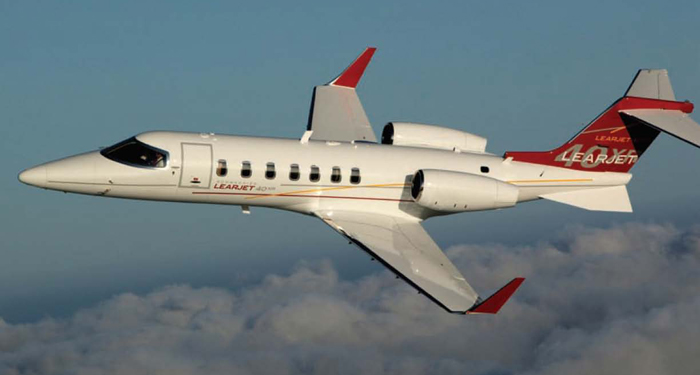
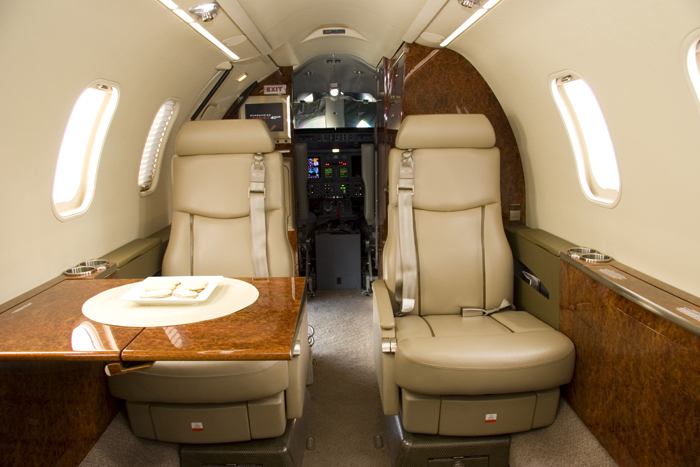
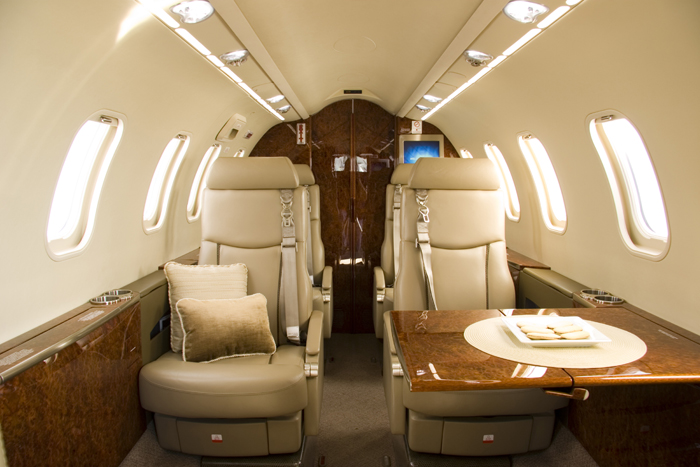
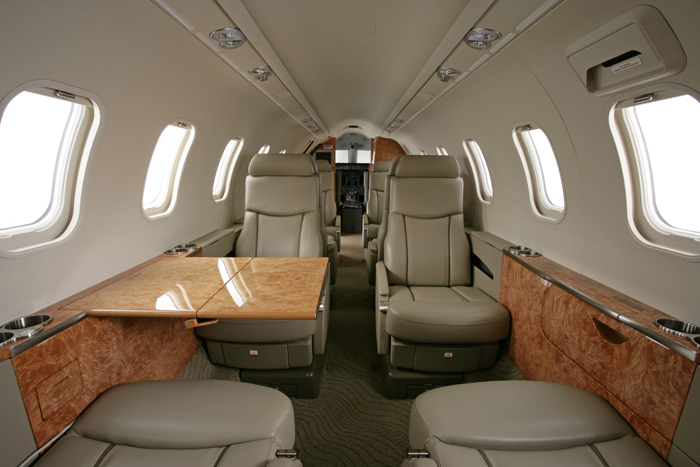
Learjet 40 XR Performance
Outpacing the competition with its enhanced engine performance, the Bombardier Learjet 40 XR business jet rockets to 51,000 feet (15,545 m) soaring above traffic and bad weather. Fully fueled it flies 7 passengers to their destinations faster than any competing jet.
Learjet 40 XR Technology
With its premium ergonomic environment, “dark cockpit” methodology and advanced avionics, the Bombardier Learjet 40 XR offers pilots more systems safety features than any competitive jet in its class.
Certification
The Bombardier Learjet 40 XR business jet complies with exceptionally rigorous standards. In fact, it is certified to a higher level than any of its direct competitors—higher even than many modern airliners. This ringing endorsement by regulatory bodies testifies to both the technological benchmark the aircraft represents and the safety and reliability its operators can expect.
Regulatory approvals for the Learjet Model 40 XR include Federal Aviation Administration (FAA) Federal Aviation Regulations (FAR) 14CFR Part 25, Amendments 1 to 77 and Joint Aviation Authorities (JAA) Joint Aviation Regulations (JAR) 25 Change 13, including day, night, VFR, IFR and flight into known icing conditions. These are the most stringent standards in the industry, giving these aircraft a higher level of FAA certification than the Airbus 330/340, the same level of JAA certification as the Boeing 777, and distinguishing them as the only narrow-body jets ever to receive JAA approval.
Examples of the demanding standards the Bombardier Learjet 40 XR aircraft meets include:
• 16 G Dynamic Seat Certification, which more accurately simulates dynamic events during an accident, improves seat attachment and restraint system loading, and stiffens requirements related to head impact and leg compression injuries.
• Bird Strike in accordance with the latest amendments to FAR 25.571 (e) (1) and FAR 25.631, which demand the ability to continue safe flight following impact events.
• FAR 25.571 (e) (2) and 25.671 through Amendment 77, which requires flight control redundancy to ensure control of the aircraft in the event of system failure, disconnect or jamming.
• More stringent system requirements through Amendment 77 level of FAR 1309, such as failure hazard assessments with fault-tolerant designs that meet higher reliability criteria.
• Derogation applied in takeoff performance (equivalent to FAR 25 Amendment 92), more accurately depicting the Rejected Takeoff procedure used in flight crew training.
• More stringent ice testing requirements.
Systems
A principal advantage of the Bombardier Learjet 40 XR aircraft over other light business jets is its heritage. Capitalizing on advanced technology successfully developed for the high-performance Learjet 45 program – and leveraging Bombardier’s unmatched engineering and integration expertise – all Learjet 40 XR systems assure proven reliability and uncompromising quality. The results are performance excellence, unequalled ease of maintenance and serviceability and total operator confidence. No other aircraft in the category comes even close.
The Bombardier Learjet 40 XR business jet offers a higher level of system redundancy than any aircraft in the category. With diagnostic capability built right in, the onboard systems assure the utmost in reliability and safety, while dramatically reducing the time required for troubleshooting.
• Hydraulically powered anti-skid system for the shortest landing distance in its class
• Hydraulic system powered by two engine-driven pumps
• Flight control systems offer superior handling
• Fuel system requires no fuel control inputs; fuel automatically transfers from the fuselage storage tank to the wing tanks
• Pressurization system provides a sea-level cabin
• Environmental control system provides optimal control of the aircraft environment
• Most effective ice and rain protection; bleed air anti-ice system and wing/stabilizer anti-ice system
• Maintenance diagnostic systems reduce maintenance labor hours
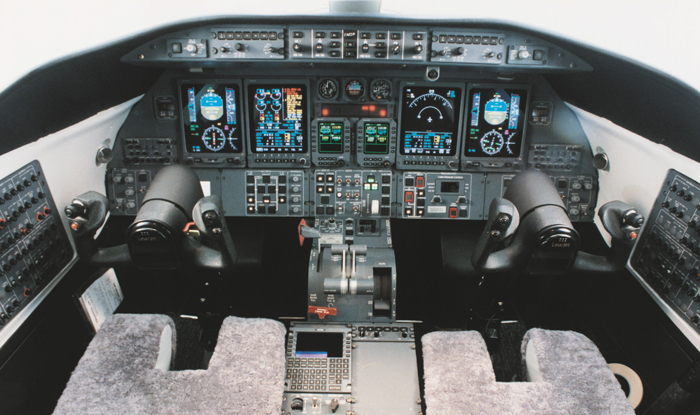
Powerplant
Imagine the power
Imagine: It’s midday in Jackson Hole, Wyoming, when a team of six executives receives an urgent call to return to New York. The temperature is 82° F (28° C), the altitude is 6,444 feet (1,964 m) above Sea Level, the runway is just 6,300 feet (1,920 m) long – and delay is not an option.
Only one light jet can rise to such a challenge. The Bombardier Learjet 40 XR aircraft, with its enhanced engines, takes off with a full complement of passengers and fuel. It powers effortlessly above the Teton Range’s highest peak, climbs directly to 45,000 feet (13,716 m) in under 30 minutes, and flies on to Teterboro, New Jersey – a distance that is over 900 nautical miles (1,667 km) farther than even the performance-driven Learjet 40 business jet could achieve.
While a Maximum Takeoff Weight increase allows the Learjet 40 XR jet to fill both the cabin and the fuel tanks, it is the increased thrust made available by its TFE-731-20-BR engines that make the aircraft’s stellar hot and high performance possible.
Imagine what that extra power can do for you under normal conditions on everyday missions.
Honeywell TFE731-20-BR-1B Engines
The Bombardier Learjet 40 XR executive aircraft is powered by two aft fuselage-mounted TFE731-20-BR-1B turbofan engines from Honeywell Engines & Systems. An upgrade of the TFE731-20-AR-1B engine, developed in partnership with Bombardier for the clean-sheet designed Bombardier Learjet 45 business jet, the TFE731-20-BR-1B brings proven maturity along with a host of high-end features that add value beyond anything else in the light jet category.
Avionics
The Bombardier Learjet 40 XR business jet is equipped with a Honeywell Primus 1000 avionics system, including an Electronic Flight Instrument System (EFIS), equipped with an EICAS, for unparalleled new levels of systems management. The EICAS integrates the multitude of electromechanical instruments that previously were required to display critical engine parameters, offering significant safety and operational benefits. The EFIS, which employs four large displays, presents vital information to the crew in an uncluttered format, simplifying cockpit scan and thereby reducing pilot workload and fatigue.
The Primus 1000 is Category II approach capable. Standard features include:
• EFIS with four 8 x 7 in (20.3 x 17.8 cm) displays
• “Dark Cockpit” methodology presents vital information on a “need-to-know” basis, suppressing extraneous data
• Dual Data Acquisition Units (DAU)
• Dual Micro Air Data Computers (MADC)
• Color Weather Radar with rain echo attenuation compensation
• EICAS provides systems and status information
• Display and Guidance Computers (DGC) integrated with autopilot, flight director, EFIS and EICAS processors
• Dual Attitude and Heading Reference System (AHRS) Fiber Optic Gyros
• Dual Honeywell Primus II Integrated Comm/Nav Radios
• Traffic Collision Avoidance System (TCAS), Enhanced Ground Proximity Warning System (EGPWS), Emergency Locator Transmitter (ELT)
Primary and Multi-Function Flight Displays
Dual Primary Flight Displays (PFD) combine attitude and Horizontal Situation Indicator (HSI) formats with airspeed, vertical speed and other essential information, such as resolution advisories for the optional Traffic Collision Avoidance System (TCAS). The Multi-Function Display (MFD) offers a full spectrum of operational advantages, from weather radar and mapping displays, to a custom e-programmable checklist. Standard pedestal width accommodates single or optional dual FMS installations.
Engine Instrumentation and Crew Alerting System (EICAS)
In addition to Primary and Multi-Function Flight Displays, the EFIS includes an EICAS, which greatly simplifies instrument panel layout and reduces pilot workload. The EICAS display replaces the majority of gauges and warning lights traditionally located throughout a cockpit. It provides engine instrumentation and supplies crew alert information in a prioritized fashion and displays the status of electrical, hydraulic, fuel, environmental and flight control systems using easy-to-read, menu-selectable schematic diagrams.
Autopilot features
The autopilot features a three-axis, fail-passive architecture (i.e. single failures are annunciated, but do not interrupt autopilot functions). This provides the ultimate control possible in all flight conditions, enhancing safety and assuring passenger comfort. A complete selection of optional avionics equipment is available for the Bombardier Learjet 40 XR aircraft.
Optional avionics
To meet current and upcoming FAA and JAR legislation, the following are available: High Frequency (HF) radios and a two-hour Cockpit Voice Recorder (CVR), which replaces the standard CVR. Other popular avionics options available for the Bombardier Learjet 40 XR business jet include airborne telephone systems, a second Flight Management System (FMS), Primus 880 Weather Radar to upgrade from the standard Primus 660 Weather Radar and Honeywell’s Airborne Flight Information System (AFIS).
Options
An aircraft is personalized through the many finishing touches that make it your own. Be your tastes conservative or unrestrained, your technology needs modest or cutting-edge, Bombardier Learjet aircraft can be outfitted to meet your preferences with a full complement of interior, exterior, equipment and avionics options.
Extended range
A new increased range option is now available for Learjet 40 XR business jets. This 268 nautical miles (NM) * (496 km) range extension is offered as an option for new Learjet 40 XR aircraft orders and for aircraft previously ordered and scheduled for delivery in the third quarter of the current fiscal year.
Flying at its long range cruise speed of Mach 0.75 (800 km/h), the Learjet 40 XR aircraft now offers a non-stop range of 1,991 NM (3,687 km)* – over 15 percent more distance covered.
The extended range increases travel flexibility to include key city pairs such as London-Cairo 1,942 NM (3,596 km), Singapore-Taipei 1,835 NM (3,398 km), Hong Kong-Jakarta 1,864 NM (3,452 km), New York-Aspen 1,519 NM (2,813 km), and Dubai-Istanbul 1,715 NM (3,176 km)*.
*under certain conditions: 4 passengers, long range cruise speed , zero wind, NBAA (100 NM) IFR fuel reserves, 85 % Boeing annual winds, ISA.
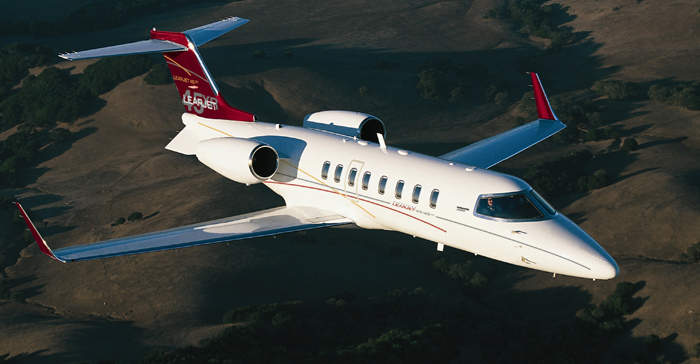
Exterior and Interior Options
Modestly detailed or proudly emblazoned with your corporate colors, the ramp appeal and interior splendor of Bombardier Learjet aircraft is but enhanced with your options – inside and out. A selection of our available options:
Exterior Options
Split Base Coat — Required for paint schemes that have two different colors for the top and bottom of the aircraft.
Interior Options
Universal Aero-M SATCOM — Includes a cockpit handset, cabin handset at seat #2 and fax/data port.
Universal Aero-I SATCOM — The Universal Aero-I SATCOM multi-channel system, in addition to the Aero-M features, provides simultaneous three-channel communication (two voice/fax or modem data channels and one packet data channel).
AirCell Airborne Cellular Telephone — The AirCell phone is a telephone system that uses the AirCell cellular ground network, interfacing with existing ground cellular systems, but is designed not to interfere with ground-based units. It has one transmitter for airborne operation and another for use on the ground. It is a single-channel telephone with a maximum transmission rate of 9,600 bits per second. It includes a cockpit handset, cabin handset at seat #2 and fax/data port.
Cabin Video System – Single DVD — The multi-format single digital video disc (DVD) system can play DVDs from all six world regions. The DVD player will also play CDs and MP3s.
Cabin Audio System — Consists of a CD player with a 10-disc changer, audio amplifier for the four cabin speakers, sub-woofer, individual seat distribution system with headset jacks at each seat location and audio output selection. Six audio headsets are included.
Airshow 400 — Cabin display of the aircraft’s current position, overlayed on a map, alternating with the display of flight information including time to destination, ground speed, altitude and temperature. Also includes a passenger audio briefing capability, cockpit controller and cabin mouse for configuring flight information. The display format includes one of the following map packages:…. North America / South America / Europe / Africa/Middle East / North Pacific / South Pacific… Note: Requires the selection of a video monitor.
Airshow Network — In addition to Airshow 400 features, Airshow Network includes up-to-the-minute financial news and stock quotes from Bloomberg, news briefs from CNN, business updates from the Wall Street Journal and current sports scores from ESPN SportsTicker. The flight crew can also access and receive airport, regional and national weather updates from the Wall Street Journal. The display format includes one of the following map packages:
North America / South America / Europe / Africa/Middle East / North Pacific / South Pacific… Note: Requires the selection of a video monitor and airborne telephone system. Airshow Network is not compatible with option 23-15-0000 Universal Aero-M SATCOM.
10.4-inch (26 cm) Aft Tracking Video Monitor — A high-resolution, flat-panel LCD screen, surface-mounted on the forward side of the aft left-hand partition. The system tracks inboard over the aisle during flight for improved viewing.
110 Volt Cabin Power System — Provides four 110 volt, 60 Hz, AC outlets in the forward galley, aft lavatory and at two specified locations in the cabin area. The inverter has a capacity of 1,200 VA.
Jump Seat — Folds out from the aft side of the left-hand forward bulkhead. Provides a stable platform while using the forward refreshment center.
Note: Not certified for takeoff or landing.
Slimline Table — A 10-inch (25-cm) wide table available at seat #4. The table pulls out of the arm ledge and includes appropriate table lights and switching.
Warming Oven — Located in the forward right-hand cabinet. Powered by the aircraft’s 28 VDC non-essential power.
Microwave — Located in the forward right-hand cabinet. Powered by the aircraft’s 115 VAC, 60 Hz non-essential power.
Note: Requires the selection of option 44-61-0000 110 Volt Cabin Power System. The microwave is designed specifically for aircraft use.
Wood Veneer Package, High Gloss Finish — A single wood veneer in a high gloss finish on all cabinets, tables, etc.
Wood Veneer Package, Satin Finish — A single wood veneer in a satin finish on all cabinets, tables, etc.
Belted Toilet — Allows the standard aft toilet to be utilized as a certified 16 G seat for takeoff and landing. Includes a life vest.
Lavatory Sink — Adds a wash basin and running tepid water, plumbed to the overboard drain.
Equipment Options
Equipment options are designed to facilitate your every mission requirement, be they for added safety or ease of operation.
A selection of our available options:
Concorde Batteries – 28 Ampere-hour (Exchange) — Includes two Concorde lead acid batteries. Provides the same power as a standard battery.. Note: Exchange for standard NiCad main batteries.
Concorde Batteries – 38 Ampere-hour (Exchange) — Includes two Concorde lead acid 24 volt, 38 ampere-hour batteries in exchange for the standard SAFT NiCad 24 volt, 27 ampere-hour batteries… Note: Meets JAA compliance requirements.
VARTA Batteries (Exchange) 24-32-0000
Includes two VARTA (VHB) nickel cadmium 24 volt, 38 ampere-hour batteries in exchange for the standard SAFT NiCad 24 volt, 27 ampere-hour batteries.
Note: Meets JAA compliance requirements.
Tail Illumination Package — Includes two lights, installed on the lower surface of the horizontal stabilizer, which illuminate both sides of the vertical stabilizer for enhanced night runway visibility. The NAV light switch is modified to add a third (NAV/LOGO) position.
Exterior Lighting Package — Provides flood lighting for the single-point refueling adapter and external baggage door areas.
Lighted Control Wheel Chart Holders — Installed at each control wheel. Provide illumination of the approach plates… Note: Required for aircraft operating under JAR-OPS 1 regulations.
Pulsating Recognition Lights — Alternately pulses outboard wing root recognition lights for enhanced aircraft visual identification.
Aircraft Locking Package — In addition to the standard configuration, which has locks on the entry door, baggage bay door and tailcone door, the optional Aircraft Locking Package provides supplemental locks for both nose avionics doors and the single-point refueling and filler door. All locks are keyed alike.
R134A Air-Conditioning System (Vapor Cycle System) — The Keith Products Vapor Cycle System provides ground air-conditioning and an auxiliary heater for ground operations. The system features separate forward and aft evaporators that independently condition the cockpit and cabin air. The air-conditioning can be powered by either a Ground Power Unit (GPU) or by both generators operating. The heater can only be powered by a GPU. The cabin and cockpit fans can be operated for air circulation without limitation.
Increased Oxygen Capacity, 40 Cubic Feet (Exchange) — Increases the aircraft’s oxygen system capacity from 23 to 40 cubic feet (651 l to 1,133 l).

Avionics Options
A complete selection of optional avionics equipment is available for Bombardier Learjet aircraft. Whether to meet current and upcoming FAA and EASA legislation, or for the latest airborne telephone systems, Bombardier can outfit your jet accordingly.
A selection of our available options:
Second Universal UNS-1E FMS — Provides second, pedestal-mounted Universal Avionics UNS-1E FMS. Note: The annual revision service is not included.
Single HF Communication with SELCAL — The Honeywell KHF-950 provides 280,000 HF frequencies at 2 to 29.999 MHz with 99 pilot-programmable preset channels. The system includes a KCU-951 control and an inverted “V” long wire antenna. The Coltech SELCAL provides selective calling for VHF 1, VHF 2 and HF.
Dual HF Communication with SELCAL — The dual Honeywell KHF-950 provides 280,000 HF frequencies at 2 to 29.999 MHz with 99 pilot-programmable preset channels. The system includes two KCU-951 controls and a single inverted “V” long wire antenna. Both HF radios can be in operation in the receive mode, but only one radio can be in transmit mode. The Coltech SELCAL provides selective calling for VHF 1, VHF 2, HF 1 and HF 2. Note: Required for certain operations for aircraft operating under JAR-OPS 1 regulations.
Honeywell Airborne Flight Information System (AFIS) — AFIS interfaces with the FMS to provide the crew with the following services from the Global Data Center: Domestic and International Flight Planning and Filing, Text Weather Services, Dispatching Services, Air Traffic Services and Message Services. The built-in VHF comm communicates with the Global Data Center through the ARINC, SITA and AVICOM networks. Coverage areas include North and Central America, Europe, Japan and parts of South America, Africa, Asia, Australia and the South Pacific. The system includes a Data Management Unit, Data Transfer Unit, Configuration Unit and antenna. Note: The AFIS cannot be selected in combination with option 31-30-0000 Digital Flight Data Recorder.
Primus 880 Radar (Exchange) — In addition to Primus 660 features, the Primus 880 radar includes Doppler Turbulence Detection, which is displayed on the weather radar map, and Altitude Compensation Tilt, which automatically adjusts radar tilt for changes in altitude.
Dual Angle of Attack Indicators — Round gauges display the relative angle of attack on pilot and co-pilot instrument panels.
Dual VHF Communication with 8.33 kHz Channel Spacing (Exchange) — VHF comm radios with 8.33 kHz channel spacing and a frequency range of 118.0 to 136.975 kHz. This option includes an 8.33 kHz capable radio management unit and a CD-850 clearance delivery unit. This radio is required in most European countries for flight above 24,500 feet (7,468 m).
Second Automatic Direction Finder (ADF) — Adds a second ADF with the same capabilities as the standard unit. Note: This option cannot be selected in combination with Aero-M or Aero-I SATCOM phones options 23-15-0000 and 23-15-0001.
Cockpit Voice Recorder (Exchange) — A solid-state Cockpit Voice Recorder that records voice and other cockpit sounds and retains them for a minimum of two hours. The unit complies with the requirements of ED-56A and TSO-C123a. Note: Required for aircraft operating under JAR-OPS 1 regulations.
UniLink — UniLink is a two-way data link which allows the crew to connect with a service provider (currently Universal Weather or Global Data Center) for any number of conveniences, such as pre-departure and oceanic clearances, flight plans, weather (including graphics), digital ATIS, Terminal Weather Information for Pilots (TWIP) and messaging. Weather maps are displayed on the UNS-1E FMS CDU. The built-in VHF comm communicates with the service provider through the ARINC, SITA and AVICOM networks. Coverage areas include North and Central America, Europe, Japan and parts of South America, Africa, Asia, Australia and the South Pacific. Note: An airborne telephone system is required to upload weather maps. Universal Weather is currently the only service provider of graphic weather maps (at the time of printing).
Digital Flight Data Recorder — A 128-word solid-state recorder that stores a minimum of 25 hours of data and complies with the requirements of FAA, TSO-C124a and EUROCAE ED-55… Note: Required for aircraft operating under JAR-OPS 1 regulations. The Digital Flight Data Recorder cannot be selected in combination with option 23-23-0001 Airborne Flight Information System (AFIS).
Lightning Detection System (LDS) — The LSZ-860 Lightning Sensor System detects electromagnetic discharges resulting from lightning activity 360 degrees around the aircraft and displays the strikes on the EFIS display with the Weather Radar. It detects lightning activity out to 200 nautical miles (370 km). Note: Installation of this option reduces storage space in the tailcone baggage compartment area.
Warranty
Along with the premium performance capabilities and comfort of the Bombardier Learjet 40 XR comes strong warranty coverage, to help you better forecast cost of ownership(1). Virtually all “Alert and Recommended Service Bulletins” issued by Learjet during the basic aircraft warranty period are covered for parts and labor.
• 5 years on airframe primary metal structure
• 5 years on airframe and airframe systems excluding completion work
• 5 years on green aircraft avionics
• 5 years or 2,000 hours(2) on engines as offered directly from engine manufacturer
• 2 years on paint and completion work
(1) Terms and conditions of the Aircraft Purchase Agreement shall at all times prevail.. (2) Which ever first occurs
